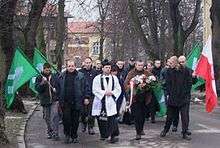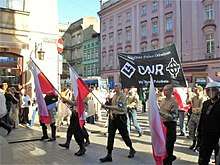Far-right politics in Poland
Like in other nations across the world, there are several far-right organizations and parties operating in Poland.
History and ideology
Past
An important element of Polish nationalism has been its identification with the Roman Catholic religion with its roots in the counter-reformation of the 17th century, and one that became established clearly in the interwar period.[1][2][3][4] Although the old Commonwealth was religiously diverse and highly tolerant,[5] the Roman Catholic religious element with messianic undertones (the Christ of Nations) became one of the defining characteristics of the modern Polish identity.[6][7][8] Roman Dmowski, a Polish politician of that era, was vital in defining that concept, and has been called the "father of Polish nationalism."[9][10][11] Dmowski was the leader of National Democracy. After his death, more radically inclined youth broke off and created the National Radical Camp. Despite previously holding few governmental positions, Polish nationalists mainly entered mainstream politics in 1937, after the death of Józef Piłsudski, who was opposed to the far-right, and the creation of the Camp of National Unity. One notable far-right policy implemented at that time was the creation of the Ghetto benches.
The post-World War II human migrations, with the resultant demographic and territorial changes of Poland that drastically reduced the number of ethnic minorities in Poland, also played a major role in the creation of the modern Polish state and nationality.[12][13]
In communist Poland the regime adopted, modified and used for its official ideology and propaganda some of the nationalist concepts developed by Dmowski. As Dmowski's National Democrats strongly believed in a "national" (ethnically homogenous) state, even if this criterion necessitated a reduced territory, their territorial and ethnic ideas were accepted and practically implemented by the Polish communists, acting with Joseph Stalin's permission. Stalin himself in 1944-45 conferred with and was influenced by a leading National Democrat Stanisław Grabski, a coauthor of the planned border and population shifts and an embodiment of the nationalist-communist collusion.[14] Consecutive Communist leaders used nationalist and patriotic rhetoric to shift public attention from the stagnating economy, including Władysław Gomułka with his pursuit of a "Polish way to socialism";[15] and giving rise to the period known as "Gomułka's thaw", Mieczysław Moczar and others. Their beliefs culminated in the "anti-Zionist" campaign of 1968. In the 1980s, Polish nationalist organizations with both pro- and anti-government stances started to emerge.
Modern

Following the collapse of a communist system in the country, the far-right ideology became visible. The pan-Slavic and neopagan Polish National Union (PWN-PSN) political party at its peak was one of the larger groups active in the early 1990s, numbering then some 4,000 members and making international headlines for its anti-Semitism and anti-Catholicism. The National Revival of Poland being a marginal political party, under the leadership of Adam Gmurczyk, operates since the late 1980s. It is a member of European National Front and a co-founder of International Third Position. The organization Association for Tradition and Culture "Niklot" was founded in 1998 by Tomasz Szczepanski, a former NOP member, promoting Slavic supremacy and neopaganism. Since the mid-1990s, the ultra-Catholic Radio Maryja station has been on air with an anti-modernist, nationalist and xenophobic program.[16] All-Polish Youth and National Radical Camp were "recreated" in 1989 and 1993, respectively becoming Poland's most prominent far-right organizations.
In 1995, the Anti-Defamation League estimated the number of far-right skinheads in Poland at 2,000, the fifth highest number after Germany, Hungary, the Czech Republic and the United States.[17] Since late 2000s, native White power skinhead, White supremacy and Neo-Nazi groups largely were absorbed into more casual and better organized "Autonomous Nationalists".

On the political level, the biggest victories achieved so far by the far-right were in the 2001, 2005, 2015, and 2019 elections. The League of Polish Families won 38 seats in 2001, and 34 in 2005. In 2015, entering parliament from the list of Kukiz'15, the far-right National Movement gained 5 seats out of Kukiz's 42. In April 2016 National Movement leadership decided to break-off with Kukiz's movement, but only one MP followed the party's instructions. The ones that decided to stay with Kukiz'15, together with few other Kukiz's MPs, formed parliamentary nationalist association called "National Democracy" (Endecja).[18] In 2019, the Confederation had the best performance of any far-right coalition to date, earning 1,256,953 votes which was 6.81% of the total vote in an election that saw a historically high turnout. Together the coalition (although de-jure a party) earned 11 seats, 5 for KORWiN, 5 for National Movement, and 1 for Confederation of the Polish Crown.
Members of far-right groups make up a significant portion of those taking part in the annual "Independence March" in central Warsaw, which started in 2009, to mark Independence Day. About 60,000 were in the 2017 march marking the 99th anniversary of independence, with placards such as "Clean Blood" seen on the march.[19]
Examples of influence
Islamophobia
There have been reports of hate crimes targeting Muslim minority in Poland. Far-right and right-wing populist political parties and organizations fuel fear and hatred towards Islam and Muslims.[20] Hate crimes such as arson and physical violence have occurred in Poland (despite having a Muslim population of only 0.1%, that is 30,000 out of 38 million).[21][22] Politicians have also made racist and anti-Muslim comments when discussing European migrant crisis;[23] in 2015, Jarosław Kaczyński claimed that Poland "can't" accept any refugees because "they could spread infectious diseases."[24] In 2017, the First Deputy Minister of Justice Patryk Jaki stated that "stopping islamization is his Westerplatte".[25]
After the 2015 elections
In May 2016, despite criticism from human rights NGOs, opposition parties and left-wing organizations, of the appeasement of the far-right, the right-wing government of Law and Justice (PiS) disbanded governmental advisory and coordinating body that dealt with "racial discrimination, xenophobia and related to them, intolerance" (Rada ds. Przeciwdziałania Dyskryminacji Rasowej, Ksenofobii i związanej z nimi Nietolerancji), by claiming that its mission was "useless".[26] As a Polish Ombudsman, Adam Bodnar is under the constant pressure from the PiS government and its controlled media; his operative budget was cut by 10 million złoty, he is labeled as a "traitor" for presenting critical report on the situation of the human rights in Poland to the UN, and the government owned and publicly paid TV channels air documentaries that claim his alleged connections to UN lawyers.[27]
See also
- Political parties in Poland
- Politics of Poland
- Confederation (political party)
References
- Geneviève Zubrzycki (15 October 2009). The Crosses of Auschwitz: Nationalism and Religion in Post-Communist Poland. University of Chicago Press. pp. 35–36. ISBN 978-0-226-99305-8. Retrieved 23 September 2013.
- Stefan Auer (22 January 2004). Liberal Nationalism in Central Europe. Routledge. p. 58. ISBN 978-1-134-37860-9. Retrieved 23 September 2013.
- Stefan Auer (22 January 2004). Liberal Nationalism in Central Europe. Routledge. p. 61. ISBN 978-1-134-37860-9. Retrieved 23 September 2013.
- Geneviève Zubrzycki (15 October 2009). The Crosses of Auschwitz: Nationalism and Religion in Post-Communist Poland. University of Chicago Press. pp. 41–43. ISBN 978-0-226-99305-8. Retrieved 23 September 2013.
- Karin Friedrich; Barbara M. Pendzich (2009). Citizenship and Identity in a Multinational Commonwealth: Poland-Lithuania in Context, 1550-1772. BRILL. p. 150. ISBN 978-90-04-16983-8. Retrieved 23 September 2013.
- Thomas K. Nakayama; Rona Tamiko Halualani (21 March 2011). The Handbook of Critical Intercultural Communication. John Wiley & Sons. p. 296. ISBN 978-1-4443-9067-4. Retrieved 23 September 2013.
- Geneviève Zubrzycki (15 October 2009). The Crosses of Auschwitz: Nationalism and Religion in Post-Communist Poland. University of Chicago Press. p. 76. ISBN 978-0-226-99305-8. Retrieved 23 September 2013.
- Geneviève Zubrzycki (15 October 2009). The Crosses of Auschwitz: Nationalism and Religion in Post-Communist Poland. University of Chicago Press. pp. 45–46. ISBN 978-0-226-99305-8. Retrieved 23 September 2013.
- Jóhann Páll Árnason; Natalie Doyle (2010). Domains and Divisions of European History. Liverpool University Press. p. 93. ISBN 978-1-84631-214-4. Retrieved 20 September 2013.
- Laura Ann Crago (1993). Nationalism, religion, citizenship, and work in the development of the Polish working class and the Polish trade union movement, 1815-1929: a comparative study of Russian Poland's textile workers and upper Silesian miners and metalworkers. Yale University. p. 168. Retrieved 20 September 2013.
- Stefan Auer (22 January 2004). Liberal Nationalism in Central Europe. Routledge. pp. 62–63. ISBN 978-1-134-37860-9. Retrieved 23 September 2013.
- Norman Davies (24 February 2005). God's Playground A History of Poland: Volume II: 1795 to the Present. Oxford University Press. p. 11. ISBN 978-0-19-925340-1. Retrieved 23 September 2013.
- Stefan Auer (22 January 2004). Liberal Nationalism in Central Europe. Routledge. p. 63. ISBN 978-1-134-37860-9. Retrieved 23 September 2013.
- Timothy Snyder (2003). The Reconstruction of Nations. Yale University Press. pp. 179–231. ISBN 978-0-300-10586-5.
- "Rebellious Compromiser". Time Magazine. 10 December 1956. Archived from the original on 2008-04-12. Retrieved 2006-10-14.
- Liang (2007), p. 265f.
- Suall et al., The Skinhead International (1995), p. 1.
- Powstało stowarzyszenie Endecja z udziałem posłów Kukiza Archived 2017-03-28 at the Wayback Machine rp.pl, 19 May 2016
- Noack, Rick (13 November 2017). "How Poland became a breeding ground for Europe's far right". Washington Post. Archived from the original on 2017-11-13. Retrieved 13 November 2017.
- Hume, Tim (9 May 2017). "Poland's populist government let far-right extremism explode into mainstream". Archived from the original on 2017-05-09. Retrieved 2017-05-11 – via news.vice.com.
- "Why are Polish people so wrong about Muslims in their country?". openDemocracy. 13 January 2017. Archived from the original on 2017-04-26. Retrieved 2017-05-11.
- "European Islamophobia Report" (PDF). SETA. 2015. Archived (PDF) from the original on 2017-09-21. Retrieved 2017-05-11.
- Leszczyński, Adam (2 July 2015). "'Poles don't want immigrants. They don't understand them, don't like them'". the Guardian. Archived from the original on 2018-06-14. Retrieved 23 April 2018.
- Editorial, Reuters. "Polish opposition warns refugees could spread infectious diseases". Archived from the original on 2018-08-01. Retrieved 23 April 2018.
- "Kto chce zakazać Koranu w Polsce". Retrieved 23 April 2018.
- "Archived copy". Archived from the original on 2016-10-12. Retrieved 2017-05-11.CS1 maint: archived copy as title (link)
- Sputnik. "Rzecznik Praw Obywatelskich atakowany przez PiS". pl.sputniknews.com. Archived from the original on 2018-08-18. Retrieved 23 April 2018.
Bibliography
- Ronnie Ferguson, Luciano Cheles, Michalina Vaughan (eds.) The Far Right in Western and Eastern Europe, Longman (1995), ISBN 978-0-582-23881-7.
- David Ost, "The Radical Right in Poland", chapter 5 in: The Radical Right in Central and Eastern Europe Since 1989 (1999), ISBN 0-271-01811-9.
- Christina Schori Liang, Europe for the Europeans: The Foreign and Security Policy of the Populist, Ashgate Publishing (2007), ISBN 0-7546-4851-6.
External links
- The Left Wing, the Far Right and the Kaczynskis Der Spiegel (2007)
- Letter from Europe: Shaping the agenda of Poland's drift to the far right International Herald Tribune (2007)
- Poland's populist government let far-right extremism explode into mainstream Vice News (2017)